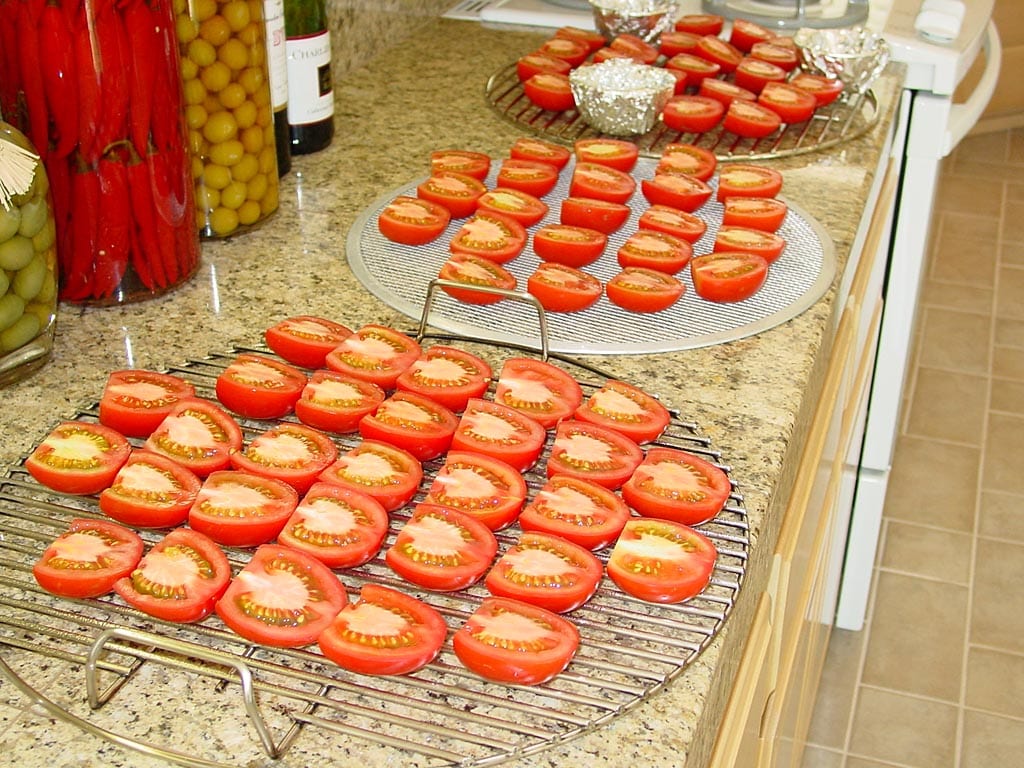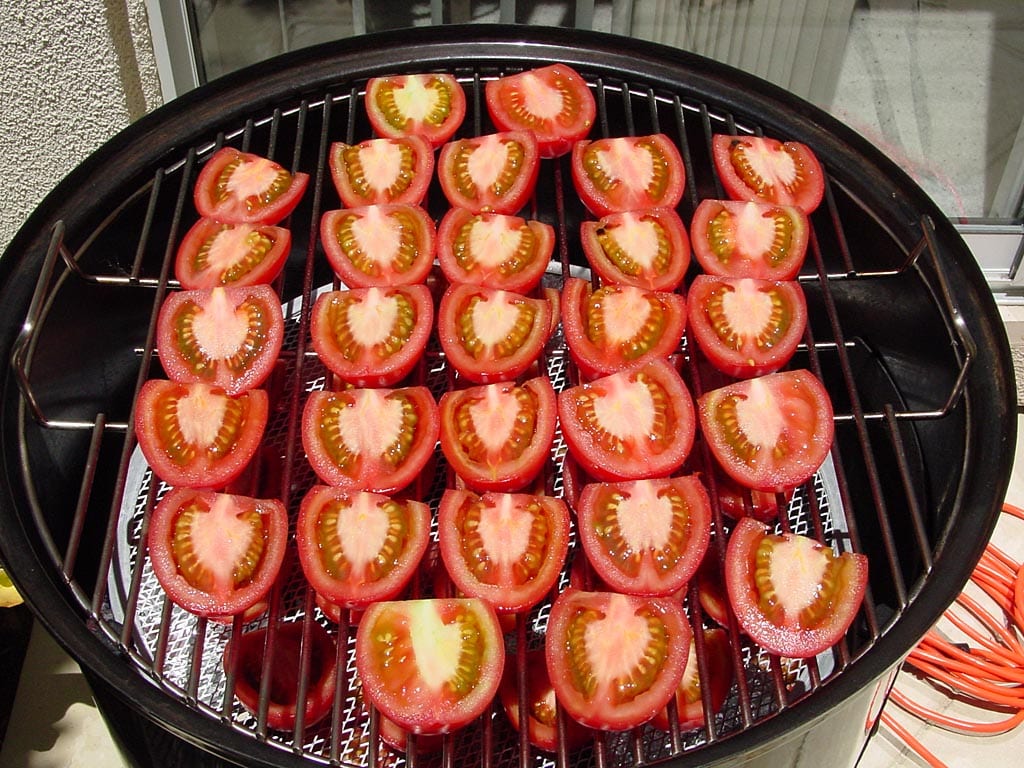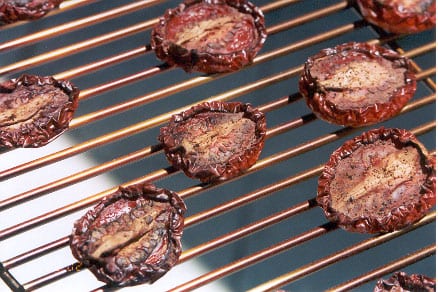In This Topic
- Selecting & Prepping The Tomatoes
- Increasing Capacity
- Drying Guidelines
- Type & Amount Of Smoke Wood
- Using An Electric Hot Plate
- Using The Minion Method
- Remove Tomatoes As They Dry
- Using A Food Dehydrator Or Electric Oven
- Storing Smoke-Dried Tomatoes
In 2002, I was watching Food Finds on Food Network and saw a man named Larry at a place called Boggy Creek Farm drying Roma tomatoes in a smokehouse. It took him 3-5 days to dry the tomatoes and he sold them in 2 ounce bags for $7.50 each.
I don’t have a smokehouse, nor do I have the patience to spend five days drying tomatoes, but I figured I could do something similar with the WSM.
You can use smoke-dried tomatoes as you would sun-dried tomatoes. Add them to pizza, pasta, casseroles, stews, sauces, soups, salads, dips, stuffing, antipastos, scrambled eggs, cornbread…the possibilities are endless!
Smoke-dried tomatoes can be packed into sterilized glass jars with or without sprigs of fresh herbs, covered with extra-virgin olive oil, and stored in the refrigerator. The olive oil becomes infused with the smoky tomato flavor and is just delicious.
Selecting & Prepping The Tomatoes
Select a plum or paste tomato variety that has a high ratio of flesh to juice. I like Roma tomatoes, which are easy to find at the grocery store or farmer’s market. Choose firm, ripe tomatoes with no blemishes.
Rinse the tomatoes under cold running water and pat dry.
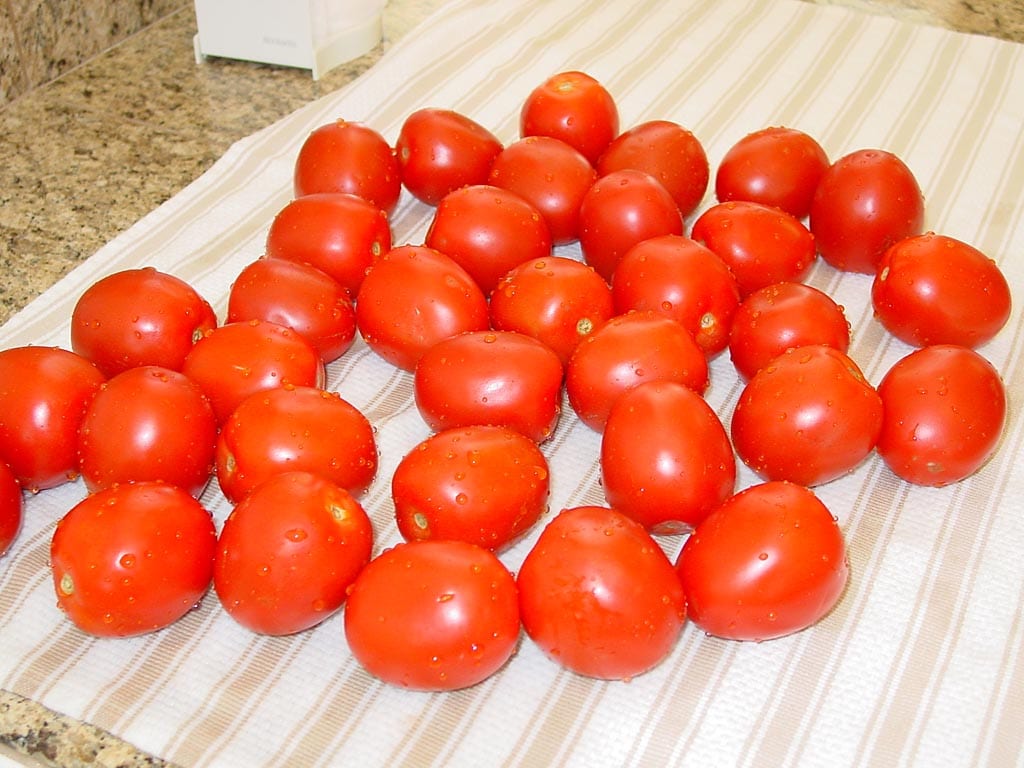
Cut the tomatoes in half lengthwise.
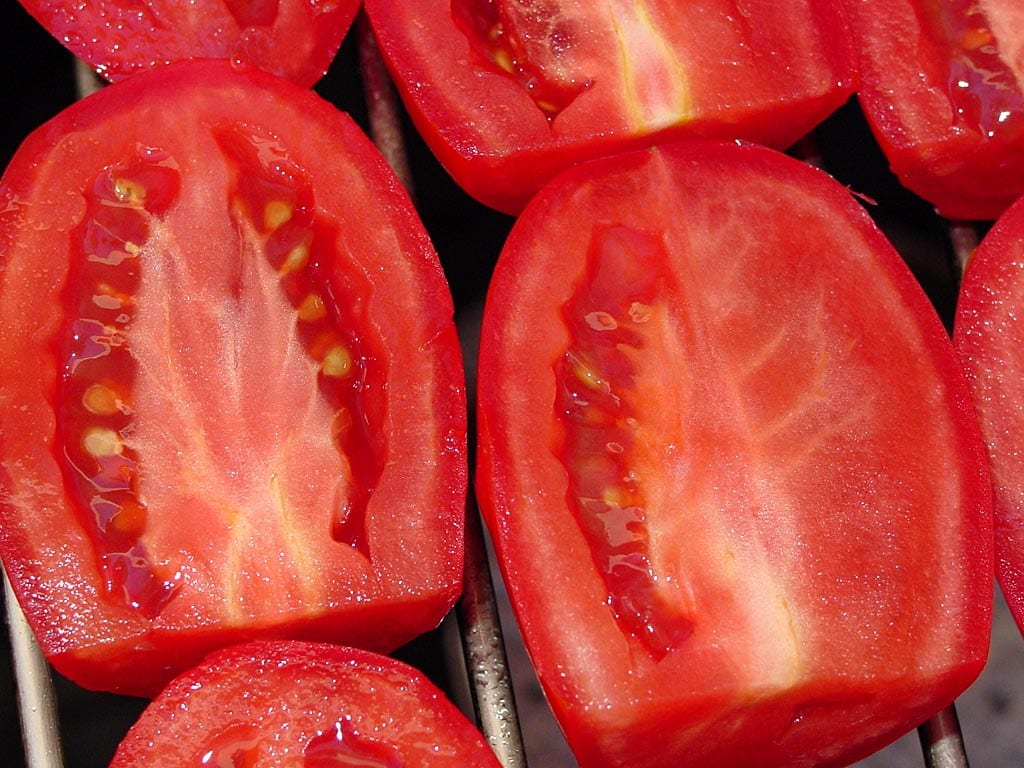
Spray the cooking grate with non-stick spray. Arrange the tomatoes cut-side up on the grate so they are not touching to allow smoke to circulate around them.
Increasing Capacity
You can easily get 40 tomato halves on a single cooking grate. To increase capacity, place additional racks over the top and bottom cooking grates.
In these pictures, I’ve arranged tomato halves on three racks. In this photo, tomatoes are arranged on the bottom cooking grate.
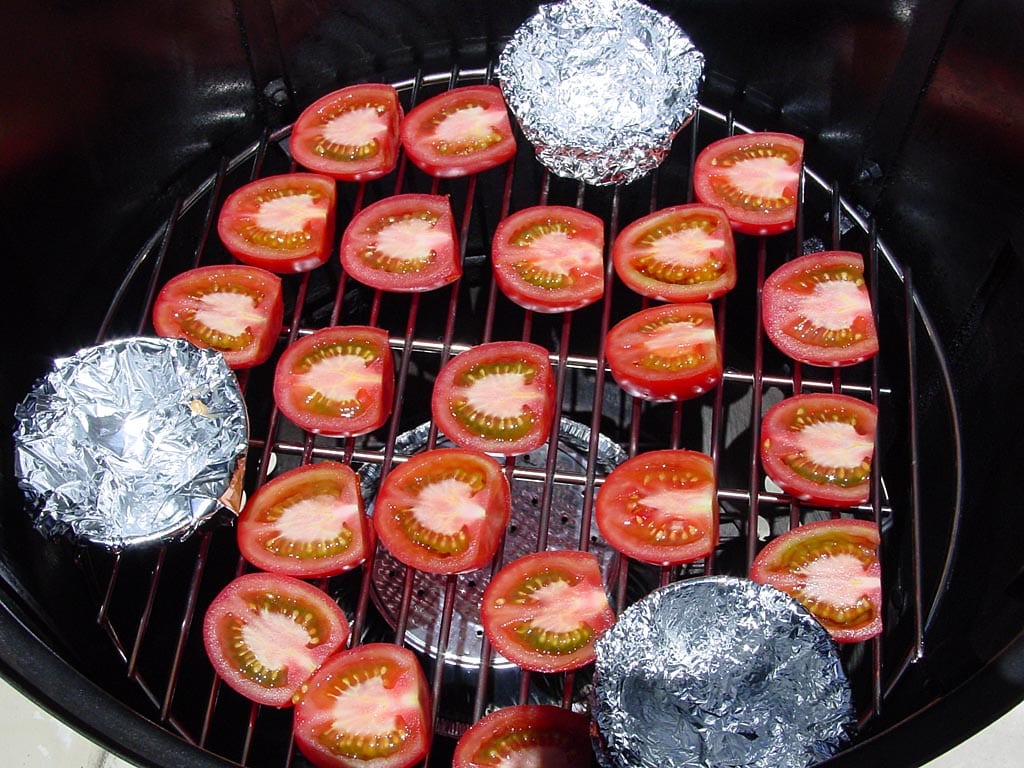
Three foil-wrapped Pyrex dessert cups are placed at the edge of the grate to support the 16″ pizza screen shown in the next photo. Pizza screens are available in various sizes at restaurant supply stores for just a few dollars.
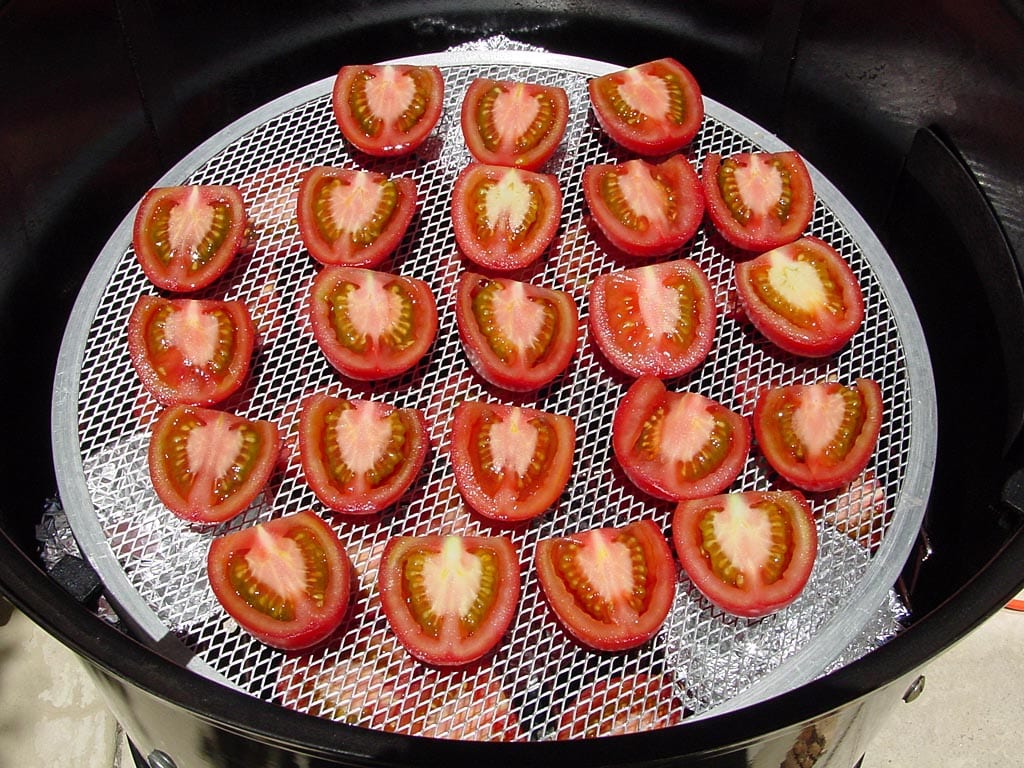
In this photo, tomatoes are arranged on the top grate. If I had wanted, I could have placed a 14″ pizza screen over the top grate, using the same method as on the bottom.
Drying Guidelines
The ideal temperature for drying tomatoes is 135°F, but my experience is that any temperature in the range of 135-160°F will work. Temps lower than these can lead to spoilage; temps higher than these can result in cooked or burned tomatoes. It takes 10-24 hours to dry tomatoes, depending on a variety of factors:
- Whether you dry the tomatoes entirely in the WSM or just apply smoke using the WSM and finish the drying in an electric oven or food dehydrator.
- The number of tomatoes being dried.
- The variety, size, shape, and water content of the tomatoes.
- Weather conditions: temperature, sun, wind, and humidity.
The tomatoes are done when they are dark red, shriveled and leathery, but still pliable, kind of like a giant raisin. They should not be brittle, nor should they be wet. A good test for doneness: no tomato pulp should stick to your finger when you touch the center of the dried tomato.
Type & Amount Of Smoke Wood
Oak or pecan are great choices for smoke-dried tomatoes. The trick is to not over-smoke them to the point they become inedible…which I did on one occasion.
If using the electric hot plate method described below, choose five small dry wood chunks, approximately 2″ x 1-1/2″ x 1/2″ each, and burn each piece individually, one after the other.
If using the Minion Method described below, mix a big handful of dry wood chips into the unlit briquettes.
Using An Electric Hot Plate
This is the fastest, easiest, and most effective way to smoke-dry tomatoes in the WSM.
Place an electric hot plate and an 8″ cast iron skillet on the charcoal grate. Set the hot plate to “High”.
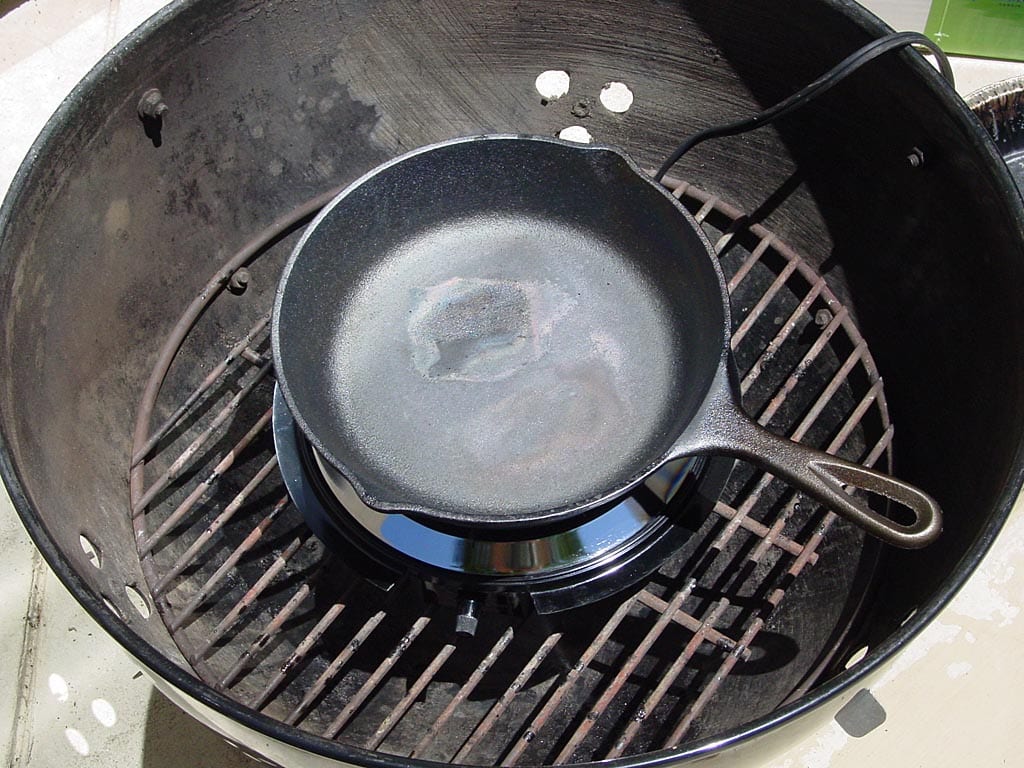
Put one small chunk of smoke wood in the skillet and place a perforated disposable pie tin over the skillet as a lid.
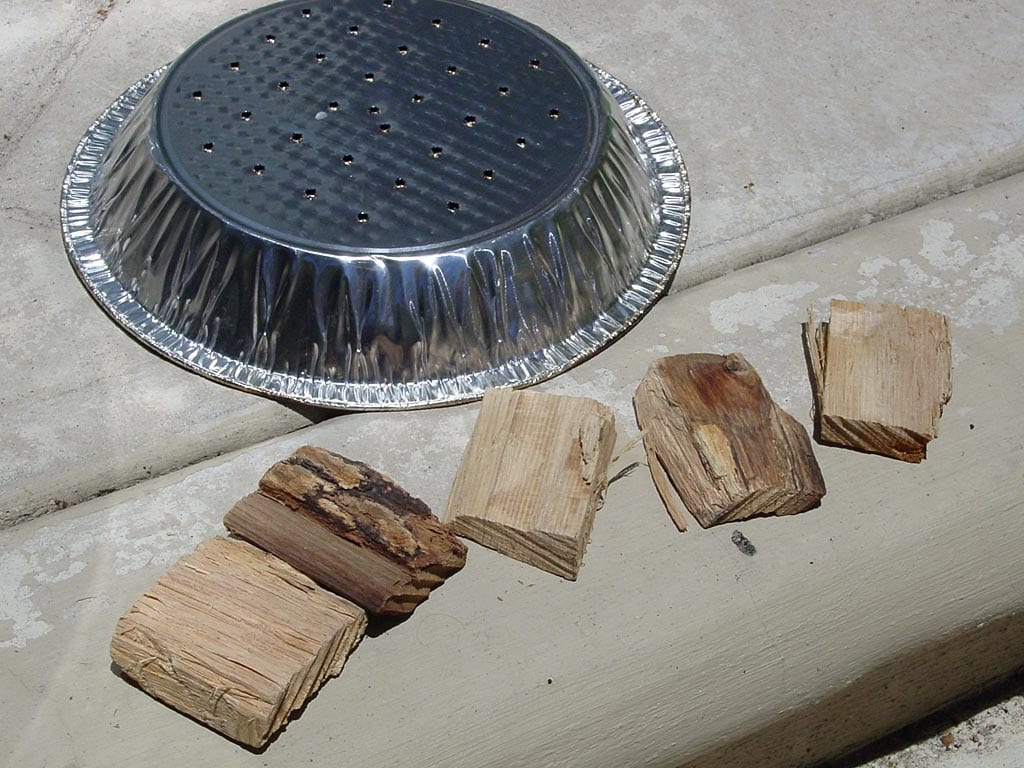
The pie tin keeps drips out of the skillet and keeps the wood from bursting into flames.
Put the middle cooking section in place and run the electrical cord out the access door opening. Fasten the door upside down so the cord exits at the bottom of the opening.
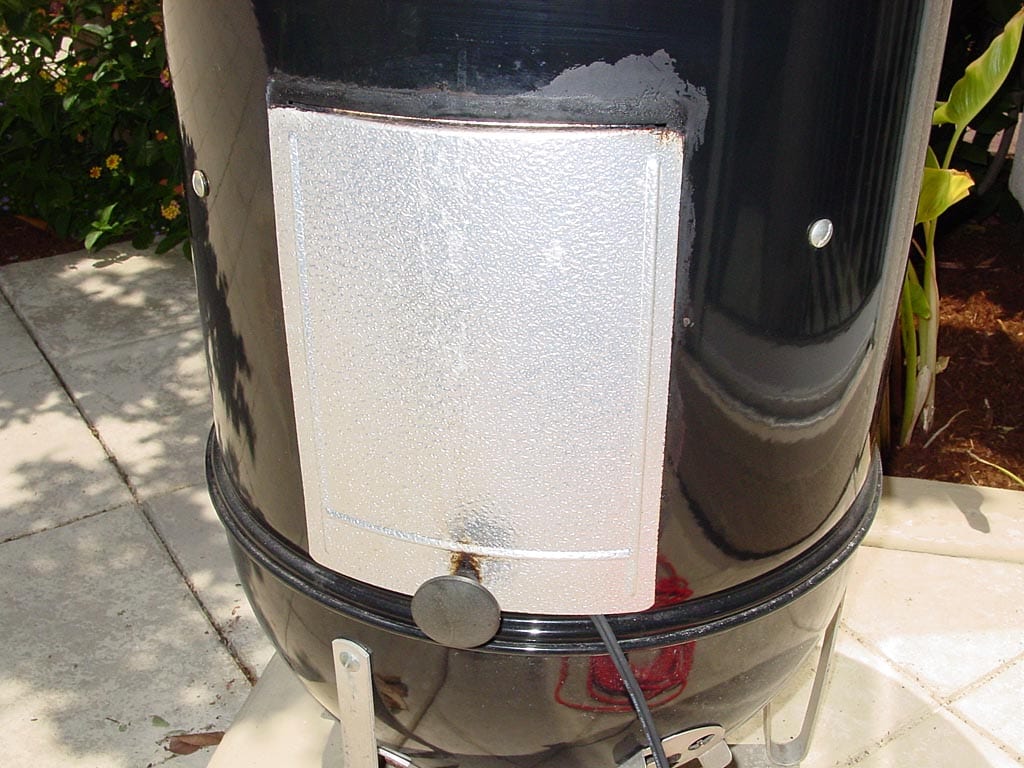
Remove the water pan from the cooker.
Place the tomatoes in the cooker. Set all vents, top and bottom, to 100% open. Plug in the hot plate and within a few minutes you’ll have smoke and 150-160°F temperatures in the cooker.
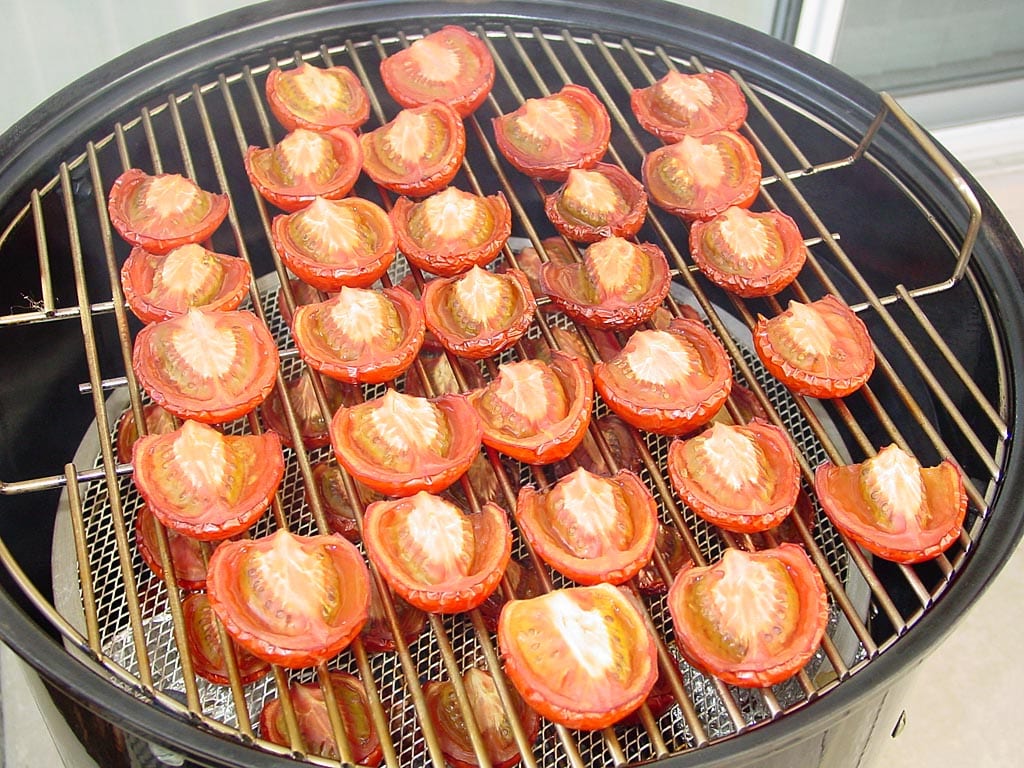
When smoke stops flowing from the top vent, carefully add another small chunk of smoke wood to the skillet. Five small chunks of smoke wood, burned one at a time, are all that’s needed.
After applying the last of the smoke wood, keep running the hot plate until the tomatoes are dried. If the cooker runs much over 160°F, adjust the hot plate to a lower setting.
It took about 14-1/2 hours to dry 72 tomato halves…here are a few of them.
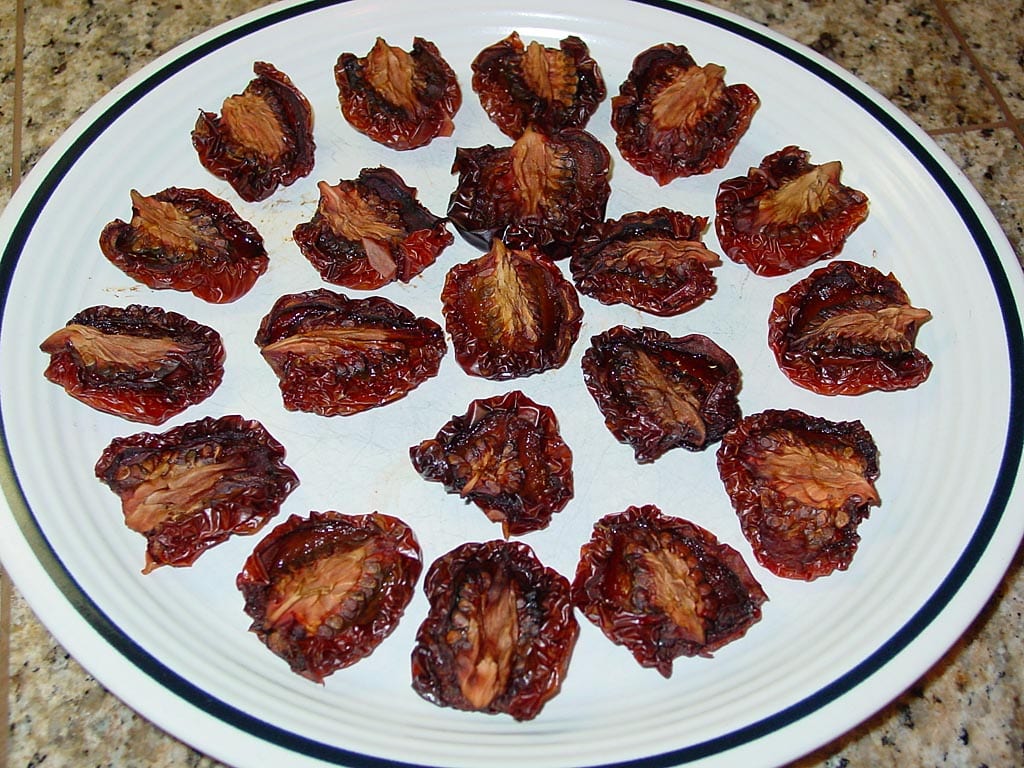
Using The Minion Method
You can use the Minion Method to achieve the 150-160°F temperatures necessary to smoke-dry tomatoes in the WSM.
Fill the charcoal chamber to the top with unlit briquettes. Mix in a big handful of dry oak or pecan smoke wood chips. Light 8-10 briquettes in a Weber chimney starter and place them on top of the unlit coals.
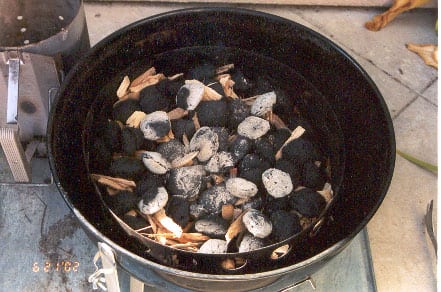
Put the middle cooking section in place and remove the water pan.
Place the tomatoes in the cooker. Set the top vent at 50% open. Close two of the bottom vents completely and set the remaining bottom vent to 20% open. This is one of the few times when you want to partially close the WSM top vent, as this helps to keep the cooker temperature low.
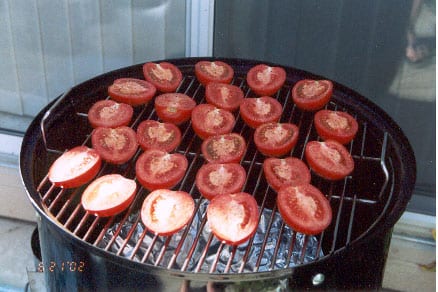
Monitor the cooker until the temp stabilizes at 150°F. Check the temperature frequently and adjust the bottom vents to maintain 150-160°F. You’ll get 18-24 hours of low heat using this method.
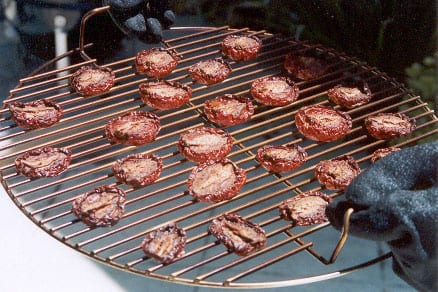
In these photos, I dried 24 tomato halves in about 26-1/2 hours.
Remove Tomatoes As They Dry
Each tomato is unique in size and moisture content and will dry at its own pace. Also, some parts of the cooker are hotter than others, so some pieces will dry faster.
In this photo, you can see there’s one little tomato in the center that’s done, while the others around it still have a way to go.
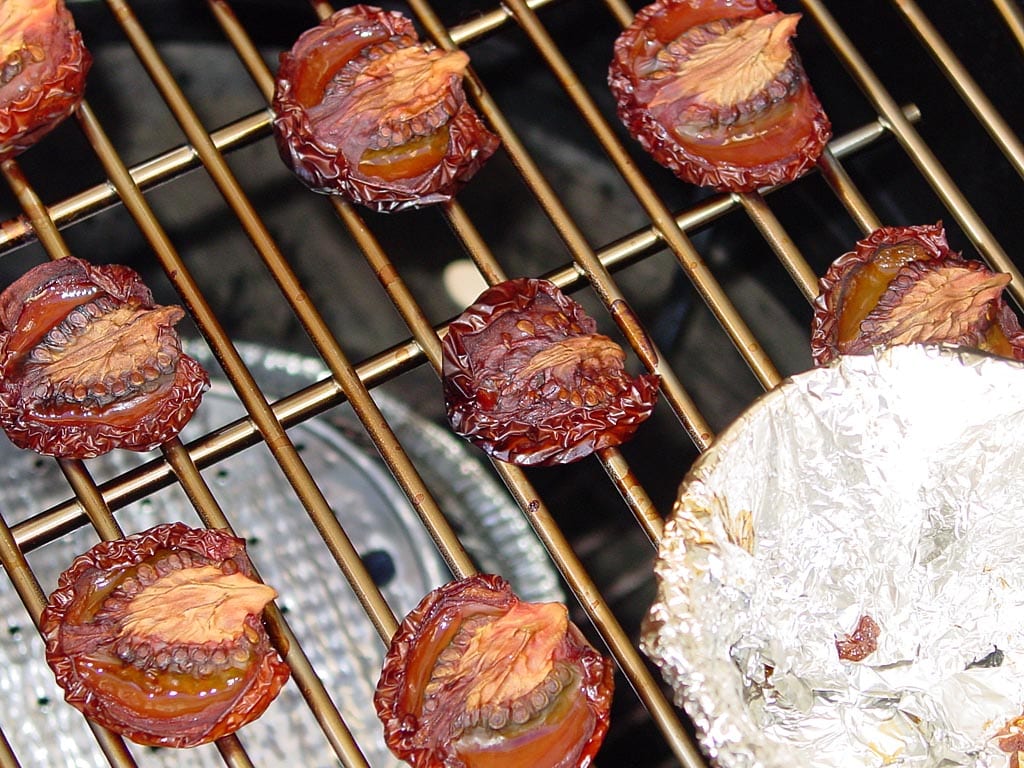
After 8-10 hours, start checking the tomatoes. Remove any pieces that meet the doneness test described in the Drying Guidelines. Check and remove pieces every 60-90 minutes thereafter.
As you remove tomatoes, rearrange the remaining pieces on the grate. If you notice “hot spots” where tomatoes dry quickly, move remaining ones into those spots for faster drying.
My experience is that tomatoes at the center of the bottom grate are the first ones to dry. Move tomatoes from the top grate to the bottom grate as space becomes available.
Using A Food Dehydrator Or Electric Oven
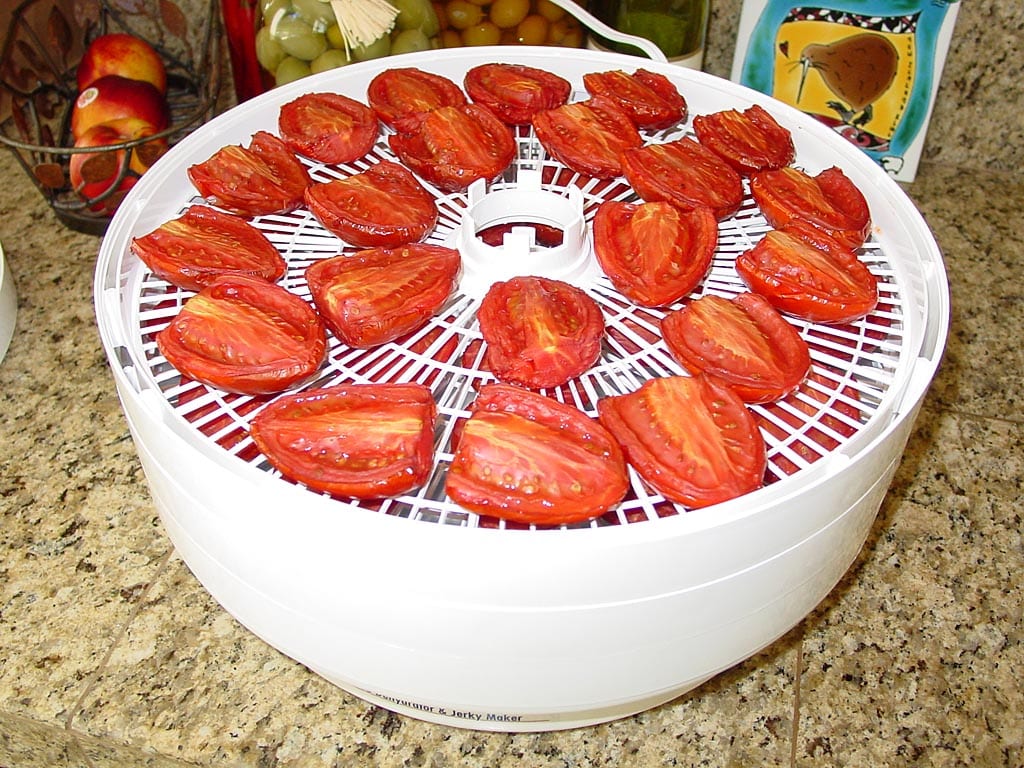 Another way to smoke-dry tomatoes is to use the electric hot plate method described above to apply the smoke flavor, then transfer the tomatoes to a food dehydrator or electric oven to finish the drying process. A gas oven is not a good choice because the combustion of natural gas produces a moist heat that greatly increases the drying time.
Another way to smoke-dry tomatoes is to use the electric hot plate method described above to apply the smoke flavor, then transfer the tomatoes to a food dehydrator or electric oven to finish the drying process. A gas oven is not a good choice because the combustion of natural gas produces a moist heat that greatly increases the drying time.
A food dehydrator is your best choice, with the entire process taking about 16 hours from start to finish.
If using an electric oven, set it to the lowest possible setting and prop open the oven door to allow moisture to escape. Since many ovens only go down to 170-180°F, propping open the door is essential.
Either way, after 8-10 hours, start checking the tomatoes every 60-90 minutes and remove those that meet the test for doneness.
Storing Smoke-Dried Tomatoes
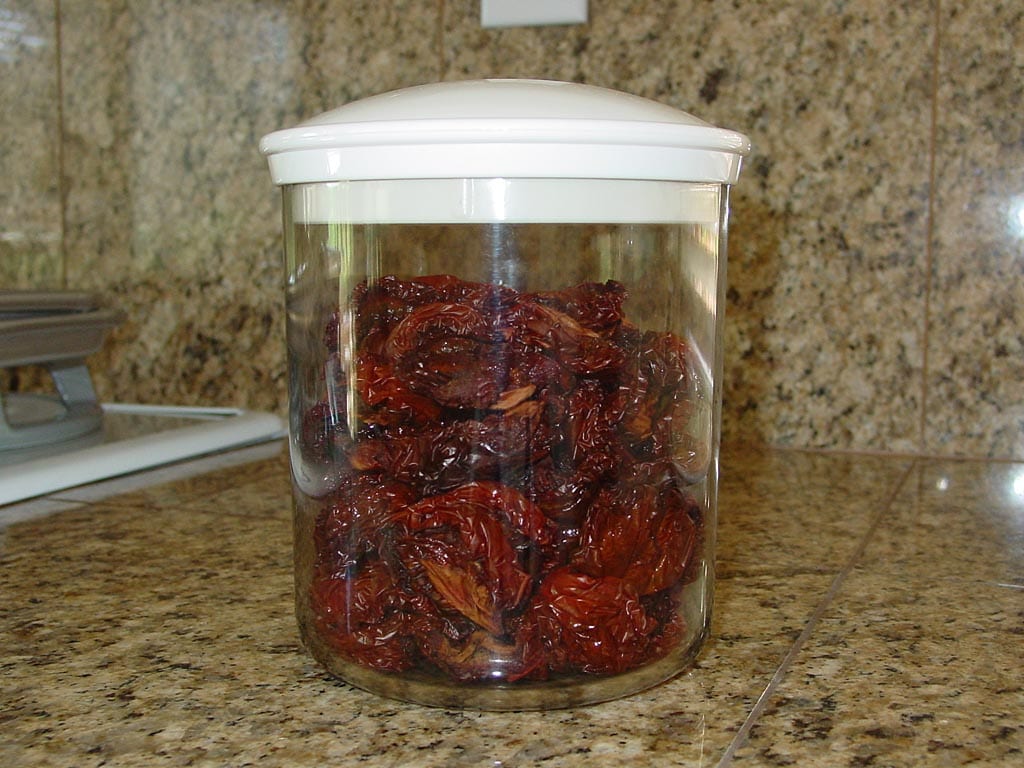
Properly dried tomatoes can be stored for 6-12 months in airtight containers or Ziploc bags in the refrigerator. They may also be frozen for up to 18 months before flavor begins to diminish. Pack the tomatoes tightly into containers to eliminate excess air. If using Ziploc bags, squeeze out as much air as possible before closing.
If you have a FoodSaver vacuum sealer, vacuum pack the tomatoes in a canning jar or FoodSaver canister. I use this method and put the sealed canister in the refrigerator, where the tomatoes last for about 12 months.

